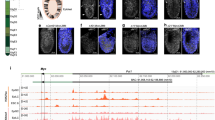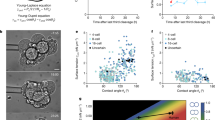Abstract
An important feature of mammalian development is the generation of sexually dimorphic reproductive tracts from the Müllerian and Wolffian ducts. In females, Müllerian ducts develop into the oviduct, uterus, cervix and upper vagina, whereas Wolffian ducts regress. In males, testosterone promotes differentiation of Wolffian ducts into the epididymis, vas deferens and seminal vesicle. The Sertoli cells of the testes produce Müllerian-inhibiting substance, which stimulates Müllerian duct regression in males1,2,3,4. The receptor for Müllerian-inhibiting substance is expressed by mesenchymal cells underlying the Müllerian duct that are thought to mediate regression of the duct5,6,7. Mutations that inactivate either Müllerian-inhibiting substance or its receptor allow development of the female reproductive tract in males8,9,10,11,12. These pseudohermaphrodites are frequently infertile because sperm passage is blocked by the presence of the female reproductive system9,10,12. Here we show that male mice lacking the signalling molecule Wnt-7a fail to undergo regression of the Müllerian duct as a result of the absence of the receptor for Müllerian-inhibiting substance. Wnt7a-deficient females are infertile because of abnormal development of the oviduct and uterus, both of which are Müllerian duct derivatives. Therefore, we propose that signalling by Wnt-7a allows sexually dimorphic development of the Müllerian ducts.
This is a preview of subscription content, access via your institution
Access options
Subscribe to this journal
Receive 51 print issues and online access
$199.00 per year
only $3.90 per issue
Buy this article
- Purchase on Springer Link
- Instant access to full article PDF
Prices may be subject to local taxes which are calculated during checkout




Similar content being viewed by others
References
Josso, N. et al . Anti-Müllerian hormone, the Jost factor Recent Prog. Horm. Res. 48, 1–59 (1993).
Cate, R. L. et al . Isolation of the bovine and human genes for Müllerian-inhibiting substance and expression of the human gene in animal cells Cell 45, 685–698 (1986).
Picard, J.-Y., Benarous, R., Guerrier, D., Josso, N. & Kahn, A. Cloning and expression of cDNA for anti-Müllerian hormone Proc. Natl Acad. Sci. USA 83, 5464–5468 (1986).
Jost, A. Problems of fetal endocrinology: the gonadal and hypophyseal hormones Recent Prog. Horm. Res. 8, 379–418 (1953).
Di Clemente, N. et al . Cloning, expression and alternative splicing of the receptor for anti-Müllerian hormone Mol. Endocrinol. 8, 1006–1020 (1994).
Baarends, W. M. et al . Anovel member of the transmembrane serine/threonine kinase receptor family is specifically expressed in the gonads and in mesenchymal cells adjacent to the Müllerian duct Development 120, 189–197 (1994).
Teixeira, J. et al . Developmental expression of a candidate Müllerian inhibiting substance type II receptor Endocrinology 137, 160–165 (1996).
Knebelmann, B. et al . Anti-Müllerian hormone Bruxelles: a non-sense mutation associated with the persistent Müllerian duct syndrome Proc. Natl Acad. Sci. USA 88, 3767–3771 (1991).
Josso, N. et al . Clinical aspects and molecular genetics of the persistent Müllerian duct syndrome Clin. Endocrinol. 47, 137–144 (1997).
Behringer, R. B., Finegold, M. J. & Cate, R. L. Müllerian-inhibiting substance function during mammalian sexual development Cell 79, 415–425 (1994).
Imbeaud, S. et al . A27 base-pair deletion of the anti-Müllerian type II receptor gene is the most common cause of the persistent Müllerian duct syndrome Hum. Mol. Genet. 5, 1269–1277 (1996).
Mishina, Y. et al . Genetic analysis of the Müllerian-inhibiting substance signal transduction pathway in mammalian sexual differentiation Genes Dev. 10, 2577–2587 (1996).
Cadigan, K. M. & Nusse, R. Wnt signaling: a common theme in animal development Genes Dev. 11, 3286–3305 (1997).
Parr, B. A. & McMahon, A. P. Dorsalizing signal Wnt-7a required for normal polarity of D-V and A-P axes of mouse limb. Nature 374, 350–353 (1995).
Cygan, J. A., Johnson, R. L. & McMahon, A. P. Novel regulatory interactions revealed by studies of murine limb pattern in Wnt-7a and En-1 mutants Development 124, 5021–5032 (1997).
Vainio, S., Heikkila, M., Kispert, A., Chin, N. & McMahon, A. P. Female development in mammals regulated by Wnt-4 signaling. Nature (submitted).
Miller, C. & Sassoon, D. Wnt-7a maintains appropriate uterine patterning during the development of the mouse female reproductive tract Development 125, 3201–3211 (1998).
Riddle, R. D. et al . Induction of the LIM homeobox gene Lmx1 by WNT7A establishes dorsoventral pattern in the vertebrate limb Cell 83, 631–640 (1995).
Vogel, A., Rodriguez, C., Warnken, W. & Izpisua-Belmonte, J. C. Dorsal cell fate specified by chick Lmx1 in the vertebrate limb. Nature 378, 716–720 (1995).
Lydon, J. P. et al . Mice lacking progesterone receptor exhibit pleiotropic reproductive abnormalities Genes Dev. 9, 2266–2278 (1995).
Lubahn, D. B. et al . Alteration of reproductive function but not prenatal sexual development after insertional disruption of the mouse estrogen receptor gene Proc. Natl Acad. Sci. USA 90, 11162–11166 (1993).
Korach, K. S. Insights from the study of animals lacking functional estrogen receptors Science 266, 1524–1527 (1994).
Korach, K. S. et al . Estrogen receptor gene disruption: molecular characterization and experimental and clinical phenotypes Recent Prog. Horm. Res. 51, 159–187 (1996).
Parr, B. A., Shea, M. J., Vassileva, G. & McMahon, A. P. Mouse Wnt genes exhibit discrete domains of expression in the early embryonic CNS and limb buds Development 119, 247–261 (1993).
Acknowledgements
We thank B. Klumpar for histology and W. Baarends for the MIS type II receptor probe. This work was supported by a grant from the NIH (to A.P.M.).
Author information
Authors and Affiliations
Corresponding author
Rights and permissions
About this article
Cite this article
Parr, B., McMahon, A. Sexually dimorphic development of the mammalian reproductive tract requires Wnt-7a. Nature 395, 707–710 (1998). https://doi.org/10.1038/27221
Received:
Accepted:
Issue Date:
DOI: https://doi.org/10.1038/27221
This article is cited by
-
Update on Mayer—Rokitansky—Küster—Hauser syndrome
Frontiers of Medicine (2022)
-
Analysis of copy number variations of WNT4 gene in a Chinese population with Müllerian anomalies
Orphanet Journal of Rare Diseases (2021)
-
Transcriptional landscape of the embryonic chicken Müllerian duct
BMC Genomics (2020)
-
Differential roles of uterine epithelial and stromal STAT3 coordinate uterine receptivity and embryo attachment
Scientific Reports (2020)
-
WNT7A Expression is Downregulated in T Lymphocytes after T-Cell Receptor Activation Due to Histone Modifications and in T-ALL by DNA Methylation
Archivum Immunologiae et Therapiae Experimentalis (2020)
Comments
By submitting a comment you agree to abide by our Terms and Community Guidelines. If you find something abusive or that does not comply with our terms or guidelines please flag it as inappropriate.



